Abstract
It is generally accepted that to cause pulmonary disease, mineral fibers must be relatively long and thin but also able to remain in the lung for long periods. This "biopersistence" of fibers is limited by two main mechanisms of fiber clearance: removal by macrophages after phagocytosis and, for some fibers, by actual dissolution. The relative importance of these mechanisms has not been properly evaluated for any type of fiber and will certainly vary with mineral type. The efficiency of macrophage clearance is greatest with short fibers (< 5 microns long) and is reduced as fibers get longer. Fibers > 50 microns long cannot be cleared by macrophages and for some mineral types they may remain in the lung permanently. Others may fracture into shorter lengths, perhaps aided by chemical dissolution, and thus become susceptible to macrophage clearance. However, for a number of areas relating to fiber removal from the lung parenchyma detailed information is still needed: Do dusts differ in their ability to attract macrophages and stimulate these cells to phagocytosis? Following dust uptake what controls the movement of macrophages? Some may penetrate to the interstitium, some phagocytosing fibers in interstitial sites may migrate back to the alveolar space. Some move to the mucociliary escalator and some to the lymphatics. Some, most importantly, move to the pleura. Fibers are found and phagocytosed in the interstitium during the early stages of disease development, but with time many fibers appear isolated in areas of fibrous tissue. Are such fibers subsequently ignored or can they reenter the disease process after years of isolation? Finally, can phagocytosis by macrophages effect dissolution of fibers?(ABSTRACT TRUNCATED AT 250 WORDS)
Full text
PDF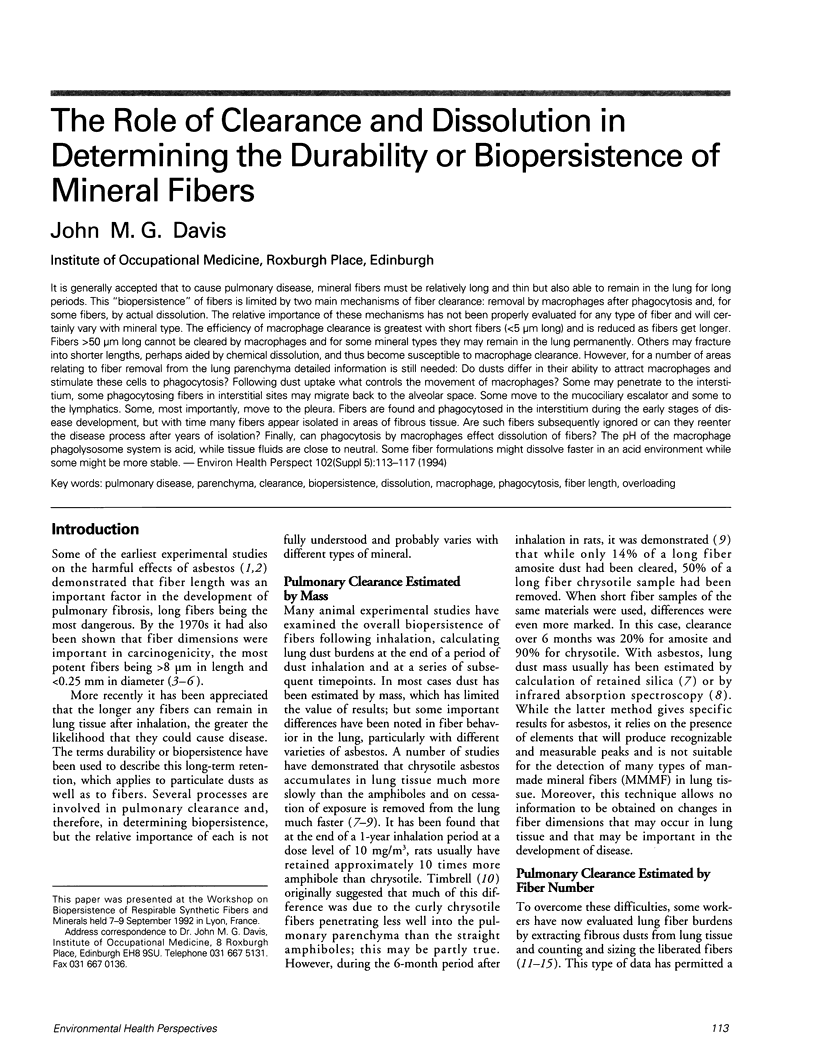
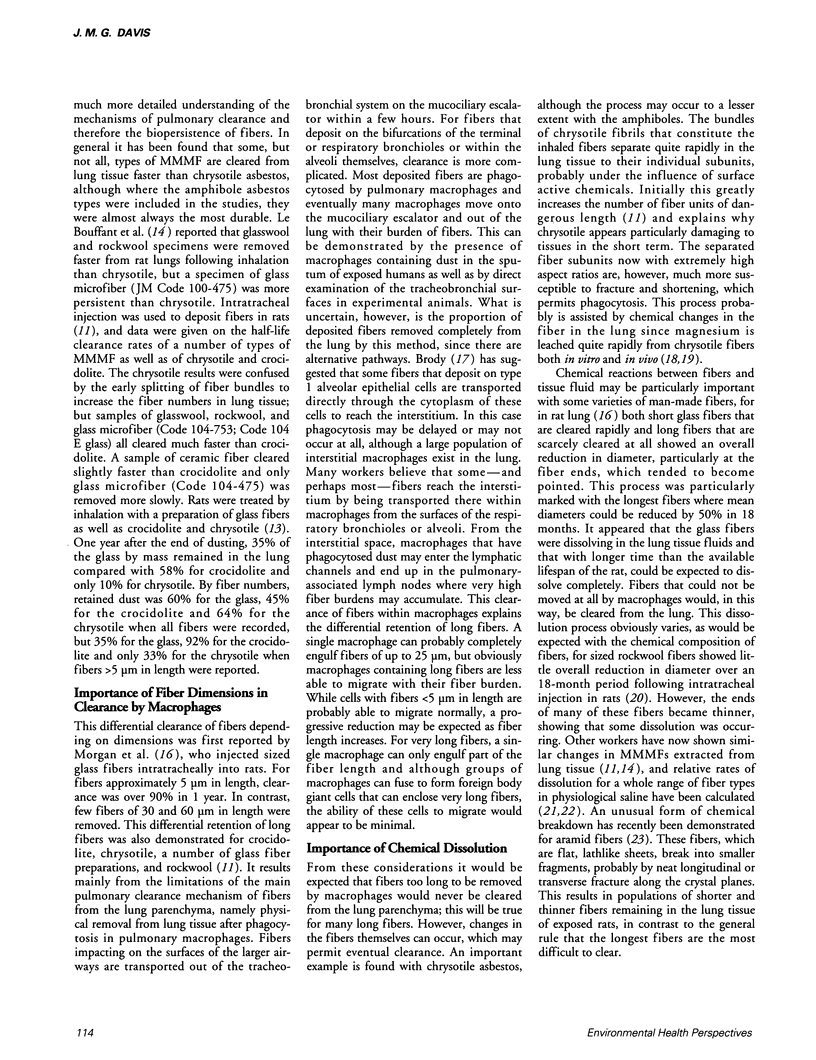
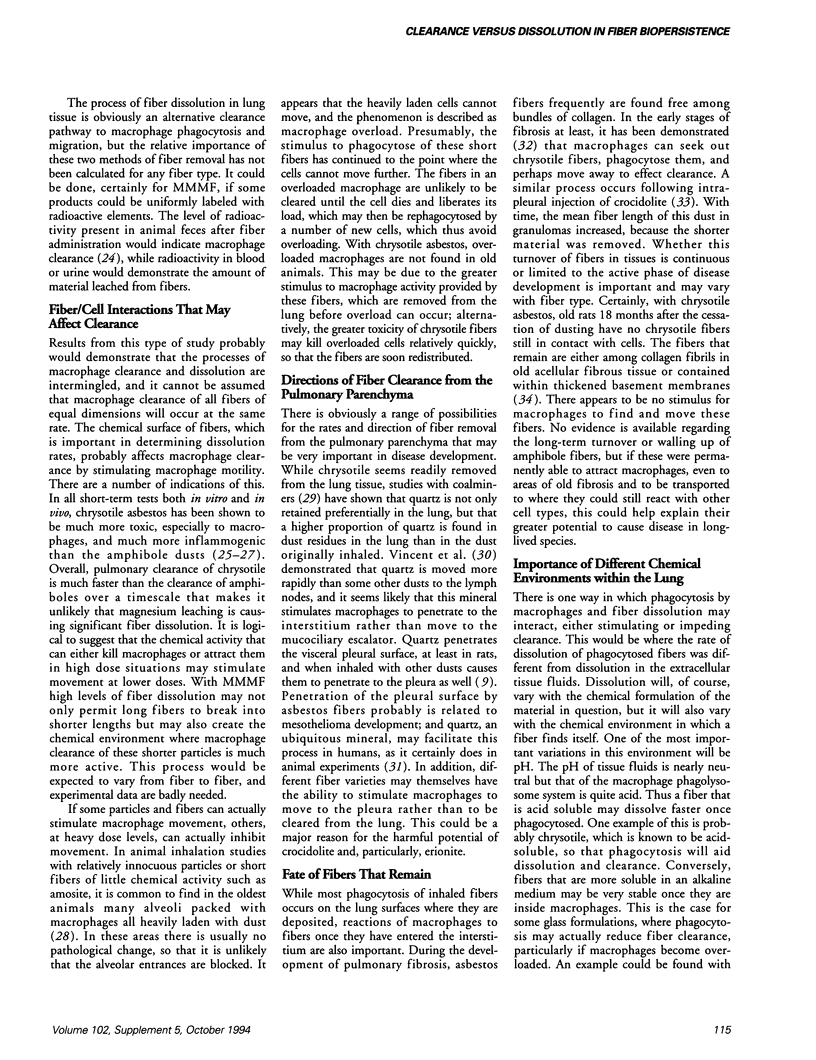
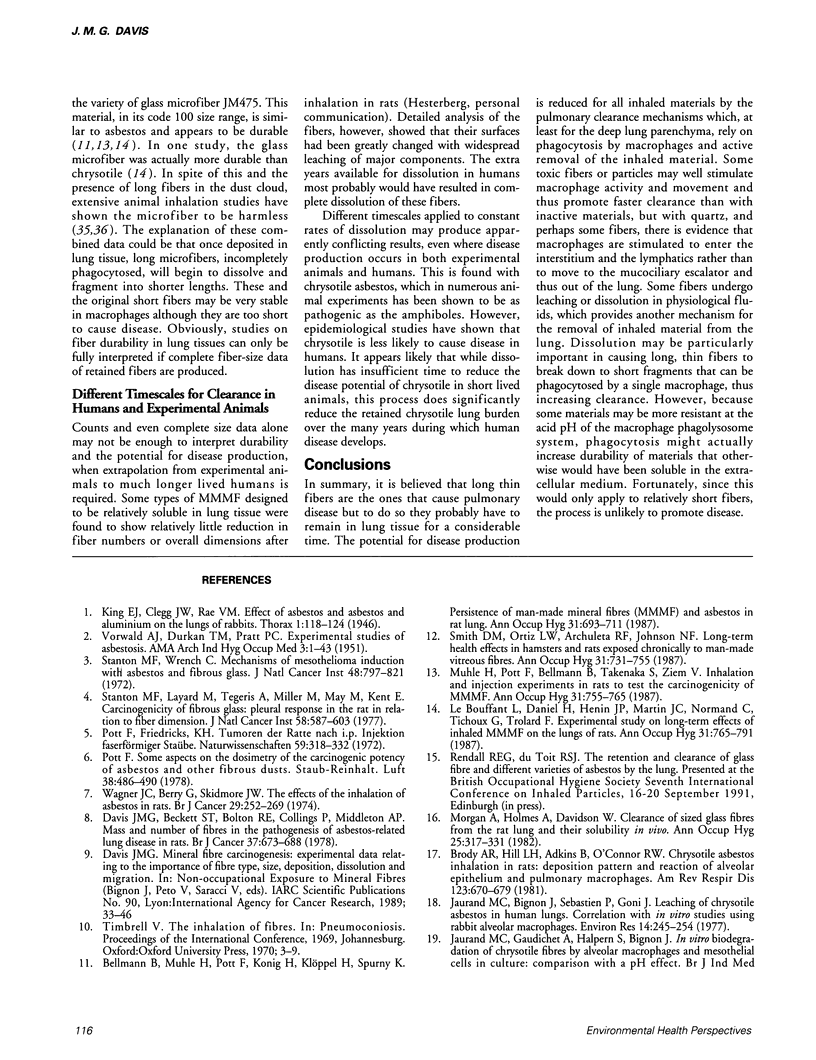
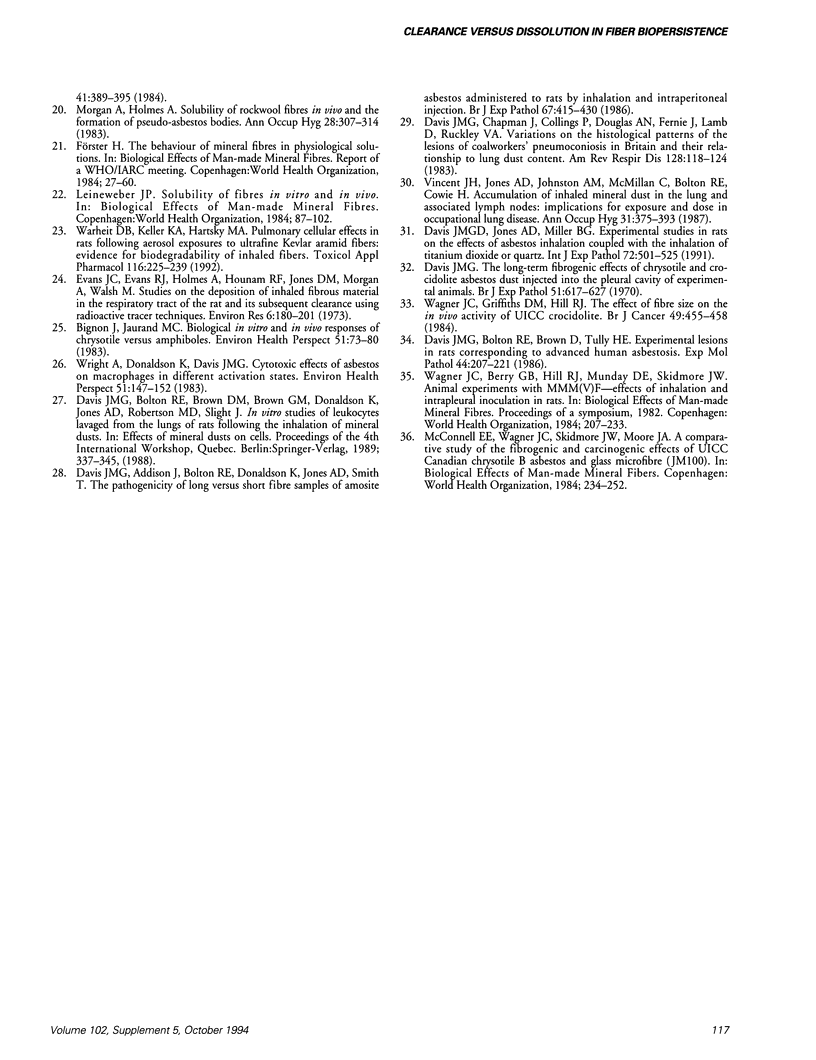
Selected References
These references are in PubMed. This may not be the complete list of references from this article.
- Bellmann B., Muhle H., Pott F., König H., Klöppel H., Spurny K. Persistence of man-made mineral fibres (MMMF) and asbestos in rat lungs. Ann Occup Hyg. 1987;31(4B):693–709. doi: 10.1093/annhyg/31.4b.693. [DOI] [PubMed] [Google Scholar]
- Bignon J., Jaurand M. C. Biological in vitro and in vivo responses of chrysotile versus amphiboles. Environ Health Perspect. 1983 Sep;51:73–80. doi: 10.1289/ehp.835173. [DOI] [PMC free article] [PubMed] [Google Scholar]
- Brody A. R., Hill L. H., Adkins B., Jr, O'Connor R. W. Chrysotile asbestos inhalation in rats: deposition pattern and reaction of alveolar epithelium and pulmonary macrophages. Am Rev Respir Dis. 1981 Jun;123(6):670–679. doi: 10.1164/arrd.1981.123.6.670. [DOI] [PubMed] [Google Scholar]
- Davis J. M., Addison J., Bolton R. E., Donaldson K., Jones A. D., Smith T. The pathogenicity of long versus short fibre samples of amosite asbestos administered to rats by inhalation and intraperitoneal injection. Br J Exp Pathol. 1986 Jun;67(3):415–430. [PMC free article] [PubMed] [Google Scholar]
- Davis J. M., Beckett S. T., Bolton R. E., Collings P., Middleton A. P. Mass and number of fibres in the pathogenesis of asbestos-related lung disease in rats. Br J Cancer. 1978 May;37(5):673–688. doi: 10.1038/bjc.1978.105. [DOI] [PMC free article] [PubMed] [Google Scholar]
- Davis J. M., Bolton R. E., Brown D., Tully H. E. Experimental lesions in rats corresponding to advanced human asbestosis. Exp Mol Pathol. 1986 Apr;44(2):207–221. doi: 10.1016/0014-4800(86)90071-7. [DOI] [PubMed] [Google Scholar]
- Davis J. M., Chapman J., Collings P., Douglas A. N., Fernie J., Lamb D., Ruckley V. A. Variations in the histological patterns of the lesions of coal workers' pneumoconiosis in Britain and their relationship to lung dust content. Am Rev Respir Dis. 1983 Jul;128(1):118–124. doi: 10.1164/arrd.1983.128.1.118. [DOI] [PubMed] [Google Scholar]
- Davis J. M., Jones A. D., Miller B. G. Experimental studies in rats on the effects of asbestos inhalation coupled with the inhalation of titanium dioxide or quartz. Int J Exp Pathol. 1991 Oct;72(5):501–525. [PMC free article] [PubMed] [Google Scholar]
- Davis J. M. The long term fibrogenic effects of chrysotile and crocidolite asbestos dust injected into the pleural cavity of experimental animals. Br J Exp Pathol. 1970 Dec;51(6):617–627. [PMC free article] [PubMed] [Google Scholar]
- Evans J. C., Evans R. J., Holmes A., Hounam R. F., Jones D. M., Morgan A., Walsh M. Studies on the deposition of inhaled fibrous material in the respiratory tract of the rat and its subsequent clearance using radioactive tracer techniques. 1. UICC crocidolite asbestos. Environ Res. 1973 Jun;6(2):180–201. doi: 10.1016/0013-9351(73)90032-7. [DOI] [PubMed] [Google Scholar]
- Jaurand M. C., Bignon J., Sebastien P., Goni J. Leaching of chrysotile asbestos in human lungs. Correlation with in vitro studies using rabbit alveolar macrophages. Environ Res. 1977 Oct;14(2):245–254. doi: 10.1016/0013-9351(77)90036-6. [DOI] [PubMed] [Google Scholar]
- Le Bouffant L., Daniel H., Henin J. P., Martin J. C., Normand C., Tichoux G., Trolard F. Experimental study on long-term effects of inhaled MMMF on the lungs of rats. Ann Occup Hyg. 1987;31(4B):765–790. doi: 10.1093/annhyg/31.4b.765. [DOI] [PubMed] [Google Scholar]
- Morgan A., Holmes A., Davison W. Clearance of sized glass fibres from the rat lung and their solubility in vivo. Ann Occup Hyg. 1982;25(3):317–331. doi: 10.1093/annhyg/25.3.317. [DOI] [PubMed] [Google Scholar]
- Morgan A., Holmes A. Solubility of rockwool fibres in vivo and the formation of pseudo-asbestos bodies. Ann Occup Hyg. 1984;28(3):307–314. doi: 10.1093/annhyg/28.3.307. [DOI] [PubMed] [Google Scholar]
- Muhle H., Pott F., Bellmann B., Takenaka S., Ziem U. Inhalation and injection experiments in rats to test the carcinogenicity of MMMF. Ann Occup Hyg. 1987;31(4B):755–764. doi: 10.1093/annhyg/31.4b.755. [DOI] [PubMed] [Google Scholar]
- Pott F., Friedrichs K. H. Tumoren der Ratte nach i.p.-Injektion faserförmiger Stäube. Naturwissenschaften. 1972 Jul;59(7):318–318. doi: 10.1007/BF00593370. [DOI] [PubMed] [Google Scholar]
- Smith D. M., Ortiz L. W., Archuleta R. F., Johnson N. F. Long-term health effects in hamsters and rats exposed chronically to man-made vitreous fibres. Ann Occup Hyg. 1987;31(4B):731–754. doi: 10.1093/annhyg/31.4b.731. [DOI] [PubMed] [Google Scholar]
- Stanton M. F., Laynard M., Tegeris A., Miller E., May M., Kent E. Carcinogenicity of fibrous glass: pleural response in the rat in relation to fiber dimension. J Natl Cancer Inst. 1977 Mar;58(3):587–603. doi: 10.1093/jnci/58.3.587. [DOI] [PubMed] [Google Scholar]
- Stanton M. F., Wrench C. Mechanisms of mesothelioma induction with asbestos and fibrous glass. J Natl Cancer Inst. 1972 Mar;48(3):797–821. [PubMed] [Google Scholar]
- VORWALD A. J., DURKAN T. M., PRATT P. C. Experimental studies of asbestosis. AMA Arch Ind Hyg Occup Med. 1951 Jan;3(1):1–43. [PubMed] [Google Scholar]
- Vincent J. H., Jones A. D., Johnston A. M., McMillan C., Bolton R. E., Cowie H. Accumulation of inhaled mineral dust in the lung and associated lymph nodes: implications for exposure and dose in occupational lung disease. Ann Occup Hyg. 1987;31(3):375–393. doi: 10.1093/annhyg/31.3.375. [DOI] [PubMed] [Google Scholar]
- Wagner J. C., Berry G., Skidmore J. W., Timbrell V. The effects of the inhalation of asbestos in rats. Br J Cancer. 1974 Mar;29(3):252–269. doi: 10.1038/bjc.1974.65. [DOI] [PMC free article] [PubMed] [Google Scholar]
- Wagner J. C., Griffiths D. M., Hill R. J. The effect of fibre size on the in vivo activity of UICC crocidolite. Br J Cancer. 1984 Apr;49(4):453–458. doi: 10.1038/bjc.1984.72. [DOI] [PMC free article] [PubMed] [Google Scholar]
- Warheit D. B., Kellar K. A., Hartsky M. A. Pulmonary cellular effects in rats following aerosol exposures to ultrafine Kevlar aramid fibrils: evidence for biodegradability of inhaled fibrils. Toxicol Appl Pharmacol. 1992 Oct;116(2):225–239. doi: 10.1016/0041-008x(92)90302-9. [DOI] [PubMed] [Google Scholar]
- Wright A., Donaldson K., Davis J. M. Cytotoxic effect of asbestos on macrophages in different activation states. Environ Health Perspect. 1983 Sep;51:147–152. doi: 10.1289/ehp.8351147. [DOI] [PMC free article] [PubMed] [Google Scholar]


